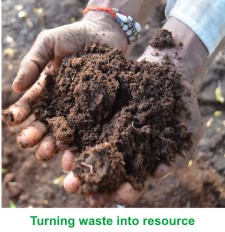|
Environment Responsibility
of Organisations
The
annual global waste production will increase by 70% if current
conditions exist, according to “What a waste 2.0”, a newly published report from
the World Bank. At present, around 2.01 billion metric tonnes of
municipal solid waste are produced annually worldwide.
exist, according to “What a waste 2.0”, a newly published report from
the World Bank. At present, around 2.01 billion metric tonnes of
municipal solid waste are produced annually worldwide.
According to ‘What a waste - the World Bank
report (2012)’, organic waste occupies around 46% out of the total solid
waste generated in the world. As seen in the table given below, organic
waste occupies the highest fraction of waste in all categories of
countries - low income, lower middle income, upper middle income and
high income countries. Hence it is integral to view this issue as
critical as management of plastic or non – biodegradable waste. Organic
waste, if dealt with resource efficiently, can be brought back into the
eco-system thereby restoring the lost nutrients of the soil.
Currently, many organisations deal with
organic waste within their institutions very systemically thereby
contributing to sustainability and food security. One such example is of
IKEA, where they have provided systemic end- to end solutions for
organic waste management.
Case Study
In October, 2009, IKEA- the well-known
Swedish furniture store partnered with Cyrenians Organic Waste Recycling
(CORE) to apply a two-phase approach methodology to food waste
management in their Edinburg store. IKEA successfully introduced the
segregation of all food waste produced during the on-site food
preparation process in phase one. This waste started to be sent for
treatment in the local anaerobic digestion plant, where it was processed
to make fertiliser and energy. Phase two of the food recycling project
started in June 2011 and this was focussed at dealing with the food
waste in the IKEA cafeteria, which was mainly composed of food
leftovers. This phase included doubling the size of the cafeteria and
implementing a highly efficient segregation scheme in the public areas.
A central recycling hub was built in the cafeteria, with a three-bin
system for food waste, general waste and recycling. The hub is user
friendly and clearly explains to the employees where to place their
waste, what can be recycled and what goes to the landfill. Engagement of
all employees to participate in this process had an important role, and
so detailed practical training sessions were given to all staff members.
As a result, between October 2009 and May
2011, CORE collected an average of 2.1 tonnes each month from the
kitchen. Phase 2 of the project which spanned across six months, enabled
the collection of 6.5 tonnes each month. Also, due to staff training,
less than 3% of the food waste collected had other materials in it.
Around 99% of food waste collected by CORE was processed through
anaerobic digestion and the product was sold to farmers as a nutrient-
rich organic fertilizer.
Some clear and evident benefits of
practising this approach was that IKEA reduced its green-house gas
emissions and saved 15.2 tonnes of CO2 and 6.8 tonnes of methane every
month and saved 1200 Euros per month.
Therefore, organic waste recycling not only
has clear environmental impacts, but also provides high business
opportunities with monetary benefits.
■

Aishwarya Varadharajan
avaradharajan@devalt.org
Back to Contents
|